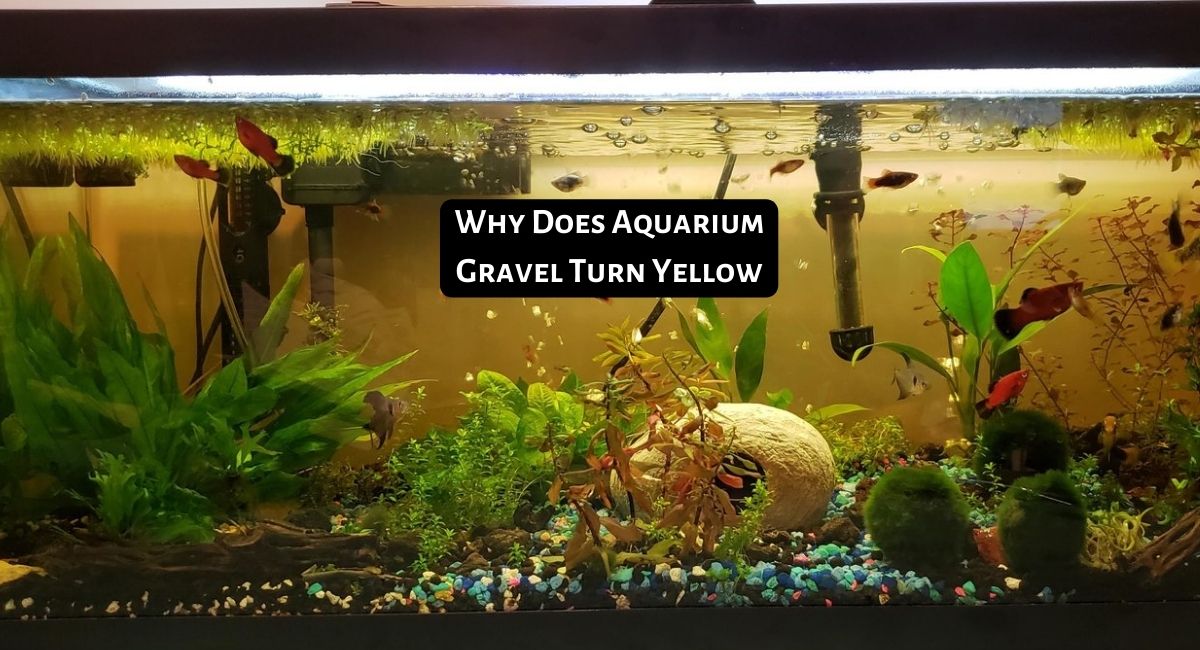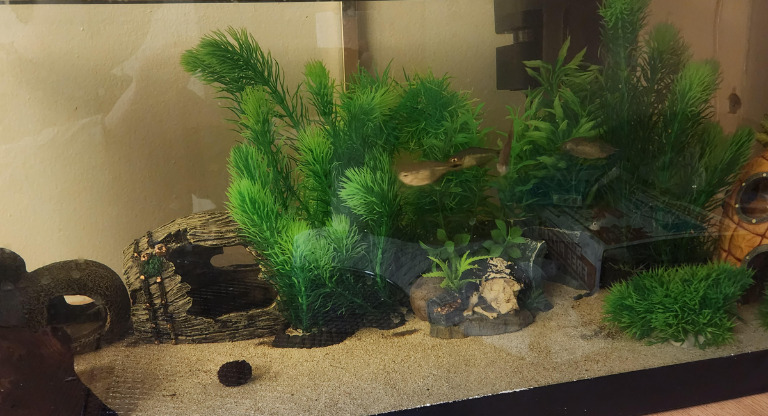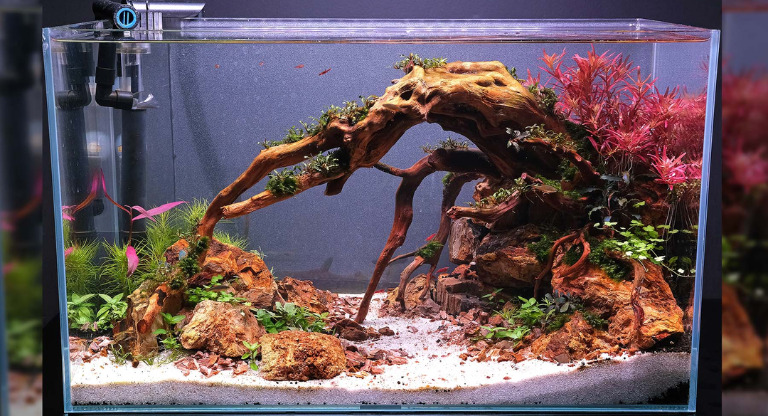Smartplantedaquarium.com participates in affiliate marketing programs. We may earn commissions on purchases made through our affiliate links. This doesn't affect our content or recommendations and we only recommend products we would put in our own tanks.
Have you ever wondered why the sand and gravel in your aquarium sometimes take on a mysterious yellow hue? It’s a common question among aquarium enthusiasts, and in this article, we’re going to dive deep into the science behind this phenomenon.
Yellow aquarium substrate can be a bit perplexing, but fear not – we’ll explain the reasons behind it and provide you with practical tips to keep your underwater world looking pristine. Let’s unravel the secrets of the yellowing aquarium substrate together!
Contents
- Key Takeaways
- Why Does Aquarium Sand and Gravel Turn Yellow
- How To Fix Yellowed Aquarium Sand and Gravel
- How to Stop Aquarium Gravel From Turning Yellow
- Conclusion
- Frequently Asked Questions
- 1. Can yellow aquarium substrate harm my fish?
- 2. How often should I clean my aquarium substrate?
- 3. Are there any natural remedies to combat substrate yellowing?
- 4. What other factors can contribute to yellowing besides those mentioned above?
- 5. How can I prevent or remove stubborn yellow stains from aquarium substrate?
- 6. Why is My Aquarium Gravel Turning Yellow?
Key Takeaways
- The yellowing of aquarium sand and gravel can be caused by dead plant material, fish waste, uneaten food, diatoms, yellow or mustard algae, driftwood and decorations, water parameters, and bacterial pigments.
- To fix yellowed aquarium sand and gravel, remove dead plant material, clean the substrate during routine maintenance, scrub and remove algae, soak and pre-treat driftwood or decorations, adjust water parameters, and improve water quality and filtration.
- To prevent aquarium gravel from turning yellow, regularly maintain the tank by performing water changes and vacuuming the substrate, practice optimal feeding practices, control light exposure, enhance filtration, monitor and adjust water parameters, choose decorations wisely, and combat algae growth.
- Yellow aquarium substrate itself is not harmful to fish, but the factors causing it to turn yellow can negatively impact water quality and fish health.
- The frequency of cleaning the aquarium substrate depends on factors such as tank size, number of fish, and waste production.
- Natural remedies to combat substrate yellowing include using activated carbon and incorporating live plants.
- Other factors that can contribute to yellowing include decaying plant matter, poor water circulation, inadequate filtration, use of medications or chemicals, and certain types of substrate or decorations.
- To prevent or remove stubborn yellow stains from aquarium substrate, implement preventive measures and use effective cleaning techniques, including physically cleaning the substrate if necessary.
Why Does Aquarium Sand and Gravel Turn Yellow
Understanding the subtle changes in an aquarium can be crucial for the well-being of its inhabitants. One such change that many aquarium enthusiasts notice over time is the yellowing of sand and gravel at the bottom of their tanks. While the sight might be concerning, understanding its causes can help address the issue effectively.
- Dead Plant Material: Aquatic plants naturally shed leaves or may die off from various reasons, such as poor lighting or nutrient deficiencies. As these plant materials break down, they release tannins and other organic compounds into the water. These compounds can then settle on the substrate, causing it to turn yellow.
- Fish Waste: Fish continuously excrete waste, including ammonia and organic matter. If not adequately removed by the filtration system or regular water changes, this waste can accumulate and contribute to the discoloration of the substrate.
- Uneaten Food: Sometimes, uneaten fish food can settle on the substrate and decompose over time. The breakdown of this food can release organic compounds that stain the substrate.
- Diatoms: Diatoms are a type of algae commonly found in newly established aquariums. They often form a brownish-yellow film on various surfaces, including the substrate. Diatoms thrive in conditions where there is an abundance of silicates and light. As the tank matures and silicate levels decrease, diatom growth typically diminishes.
- Yellow or Mustard Algae: While less common, yellow or mustard algae can also be a culprit for yellowing substrate. This type of algae can attach itself to the substrate and other surfaces within the tank.
- Driftwood and Decorations: Some aquarium decorations, especially driftwood, can release tannins into the water. Tannins are natural compounds found in wood and other organic materials. Over time, these tannins leach into the water and may settle on the substrate, giving it a yellowish tint. This process is more noticeable in tanks with a lot of wood or tannin-releasing decorations.
- Water Parameters: An imbalance in water parameters, such as pH or mineral content, can sometimes affect the color of the substrate. For instance, if the water becomes too acidic or alkaline due to poor maintenance or improper buffering, it can influence the color of the substrate. This is less common but can happen in extreme cases.
- Bacterial Pigments: Certain types of bacteria in the aquarium can produce pigments that may discolor the substrate. Bacterial blooms can occur naturally and are often a part of the aquarium’s ecosystem. However, an excessive or persistent bacterial bloom could be indicative of issues with water quality or filtration, which may need to be addressed to prevent further yellowing.
How To Fix Yellowed Aquarium Sand and Gravel
Cleaning yellow aquarium substrate can be a bit of a process, and the specific steps you need to take can vary depending on the cause of the yellowing. Here’s a specific guide for each of the common issues that cause yellowing substrate:
Regular Maintenance
Remove any dead or decaying plant material using aquarium tweezers or scissors. Trim unhealthy leaves from live plants. Use a gravel vacuum or siphon to remove debris and fish waste from the substrate during routine water changes. Aim to vacuum the substrate surface thoroughly. Ensure you don’t overfeed your fish to minimize the accumulation of uneaten food. Only provide the amount of food that your fish can consume within a few minutes.
Scrubbing and Algae Removal
To address algal growth, gently scrub the affected areas of the substrate using an aquarium-safe algae scraper or a soft-bristle brush. Be careful not to scratch the substrate if it’s made of delicate materials. Remove any affected rocks or decorations and scrub them separately if they have algae growth. Consider reducing the amount of light your aquarium receives if the algal growth is excessive, as this can help prevent future outbreaks.
Soaking and Pre-Treatment
If you suspect tannins from driftwood or decorations are the cause, remove the affected items from the aquarium. Soak the driftwood or decorations in a separate container of dechlorinated water for several days to leach out excess tannins. Change the water daily. Once the water remains clear during soaking, you can return the decorations or driftwood to the tank.
Water Parameter Adjustment
Test the aquarium water parameters, including pH and mineral content, to identify any imbalances. Adjust these parameters gradually using aquarium-safe products, such as pH buffers or remineralizers, following the manufacturer’s instructions. Monitor the water parameters closely to ensure they remain stable within the desired range.
Water Quality and Filtration
Test the water for ammonia and nitrite levels, as high levels of these substances can indicate a bacterial bloom. Ensure your aquarium filtration system is functioning properly and that the filter media is clean and well-maintained. Perform partial water changes to reduce nutrient levels and improve water quality. If the bacterial bloom persists, consider using a bacterial supplement to help establish a beneficial bacterial colony that can outcompete the pigmented bacteria.
How to Stop Aquarium Gravel From Turning Yellow
Maintaining the pristine appearance of your aquarium substrate not only enhances the beauty of your setup but also ensures a healthier environment for your aquatic pets. Here are effective strategies to prevent your aquarium substrate from turning yellow:
1. Regular Maintenance:
- Weekly Water Changes: Regular water changes are crucial for maintaining water quality and preventing the accumulation of organic matter that can lead to yellowing substrate. Replace 10-25% of the tank water every week, using a siphon or gravel vacuum to remove debris from the substrate.
- Vacuum the Substrate: Use an aquarium vacuum during water changes to clean the substrate thoroughly. Gently move the vacuum over the substrate’s surface to remove uneaten food, fish waste, and detritus that can contribute to yellowing.
2. Optimal Feeding Practices:
- Avoid Overfeeding: Overfeeding is a common cause of substrate yellowing. Feed your fish only what they can consume in 2-3 minutes, and remove any uneaten food after feeding to prevent it from decomposing in the tank.
- Use High-Quality Food: Premium fish foods are less likely to break apart quickly, reducing the amount of food debris in the tank that can lead to yellowing.
3. Control Light Exposure:
- Limit Light Duration: Keep the aquarium lights on for 8-10 hours a day to mimic natural day-night cycles. Excessive light can encourage algal growth, which can affect the substrate’s appearance.
- Avoid Direct Sunlight: Place your aquarium in a location where it is not exposed to direct sunlight. Sunlight can promote rapid algal growth and contribute to substrate discoloration.
4. Enhance Filtration:
- Use Activated Carbon: Incorporate activated carbon into your filtration system. Activated carbon can adsorb tannins and other organic compounds, helping to keep the water clear and the substrate clean.
- Regular Filter Maintenance: Follow the manufacturer’s recommendations for cleaning or replacing filter media. A well-maintained filter is essential for effective mechanical and biological filtration.
5. Monitor and Adjust Water Parameters:
- Test Regularly: Use aquarium test kits to monitor water parameters such as ammonia, nitrites, nitrates, and pH. Imbalances in these parameters can lead to bacterial blooms or other issues that may affect substrate color.
- Condition the Water: Use water conditioners to neutralize harmful substances like chlorine and chloramine and to bind heavy metals that could contribute to substrate discoloration.
6. Choose Decor Wisely:
- Pre-treat Driftwood: If you plan to use driftwood in your aquarium, pre-treat it by boiling or soaking it. This helps to leach out excess tannins that can cause yellowing when the wood is placed in the tank.
- Opt for Non-Dye Decor: When selecting decorations for your aquarium, choose those that are free from dyes or colorants that might leach into the water and affect the substrate’s color.
7. Combat Algae Growth:
- Introduce Algae Eaters: Consider adding fish species or invertebrates that are known for their algae-eating behavior. For example, Otocinclus catfish and Amano shrimp are good choices. They can help keep algae growth in check.
- Consider Live Plants: Live aquatic plants compete with algae for nutrients in the water, reducing the likelihood of algal blooms that can affect the substrate’s appearance. Adding live plants can also enhance the overall aesthetics of your aquarium.
Discover common challenges like gas buildup, discoloration, and more that can plague your aquarium substrate. Learn expert tips and tricks to maintain a healthy, vibrant aquatic environment for your beloved fish and plants.
Tips to Reduce Anaerobic Gas Build Up in Aquarium Substrate: Learn the secrets to maintaining a healthy aquarium environment by preventing anaerobic gas buildup in your substrate. Discover expert tips and techniques to ensure your aquatic friends thrive in a gas-free zone.
Why is My Aquarium Sand Floating: Uncover the science behind the mysterious phenomenon of floating aquarium sand. Dive into this article to understand the causes and solutions for keeping your aquarium’s sandy substrate where it belongs – at the bottom!
Why Does Fish Tank Sand and Gravel Turn Green: Explore the fascinating world of algae blooms and their impact on your aquarium gravel. Find out why your once-pristine gravel may turn green and how to tackle this common aquatic challenge effectively.
Why Does Fish Tank Gravel and Sand Turn Black: Delve into the intriguing mystery of black aquarium sand and its origins. Learn about the factors that may cause your sand to darken and find solutions to maintain a visually appealing aquatic setup.
Why Does Fish Tank Gravel and Sand Turn Brown: Unearth the causes behind the transformation of your aquarium sand into a brownish hue. Get to the root of the issue and explore strategies for maintaining clear and attractive sand in your tank.
How to Prevent Fish Tank Substrate Compaction: Discover essential tips and techniques to prevent your aquarium substrate from compacting, ensuring a healthy and stable environment for your aquatic inhabitants. Learn how to maintain optimal conditions and promote plant growth in your planted aquarium.
Conclusion
The yellowing of aquarium sand and gravel is a natural process caused by various factors such as algae growth, trapped organic debris, and mineral buildup.
Maintaining good water quality, regular cleaning, and proper aquarium maintenance can help prevent or reduce this discoloration, keeping your aquarium environment healthy and visually appealing.
By understanding these factors, aquarium enthusiasts can enjoy the beauty of their underwater worlds for years to come.
Frequently Asked Questions
1. Can yellow aquarium substrate harm my fish?
Yellow aquarium substrate itself is not harmful to fish. However, the factors that cause the substrate to turn yellow, such as excessive waste, nutrient imbalances, and algae growth, can negatively impact water quality and the overall health of your fish. It is important to address these underlying issues to ensure a clean and healthy environment for your aquatic inhabitants.
2. How often should I clean my aquarium substrate?
The frequency of cleaning your aquarium substrate depends on several factors, including the size of your tank, the number of fish, and the amount of waste produced. As a general guideline, it is recommended to perform regular substrate cleaning during your routine water changes. This usually involves vacuuming the substrate every 1-2 weeks to remove debris and waste. However, if you notice excessive waste buildup or poor water quality, more frequent cleaning may be necessary.
3. Are there any natural remedies to combat substrate yellowing?
Yes, there are natural remedies that can help combat substrate yellowing. One effective method is the use of activated carbon in the aquarium filter. Activated carbon helps to absorb organic compounds, including tannins and other substances that cause discoloration. Additionally, incorporating live plants in your aquarium can help absorb excess nutrients and reduce algae growth, which can contribute to yellowing. Regular maintenance practices, such as proper feeding, water changes, and good filtration, also play a crucial role in preventing substrate yellowing.
4. What other factors can contribute to yellowing besides those mentioned above?
In addition to excessive waste, nutrient imbalances, and algae growth, other factors can contribute to yellowing of aquarium substrate. These include the presence of decaying plant matter, poor water circulation, inadequate filtration, the use of medications or chemicals, and the use of certain types of substrate or decorations that can release compounds into the water. It is important to assess these factors and address them accordingly to prevent or resolve yellowing issues.
5. How can I prevent or remove stubborn yellow stains from aquarium substrate?
Preventing or removing stubborn yellow stains from aquarium substrate requires a combination of preventive measures and cleaning techniques. Regular maintenance practices, such as proper feeding, regular water changes, and efficient filtration, can help prevent the buildup of waste and excess nutrients that contribute to yellowing. Additionally, using activated carbon in the filter can help remove organic compounds that cause discoloration. If yellow stains persist, you may consider physically cleaning the substrate by removing it from the aquarium and rinsing it thoroughly with dechlorinated water. Be cautious not to disrupt the biological balance of the tank while doing so.
6. Why is My Aquarium Gravel Turning Yellow?
The yellowing of your aquarium gravel can be attributed to several causes, including tannins from driftwood or organic materials, algae growth, fish waste and uneaten food, hard water, or iron oxide. While yellow gravel is generally harmless to your fish, it can be unsightly and may indicate underlying tank issues. To address this, regularly change the water, clean the gravel using a gravel vacuum, incorporate activated carbon in your filter, utilize a phosphate remover, and consider switching to a less discolored gravel type. If the issue persists, consult an aquarium expert for further guidance.






